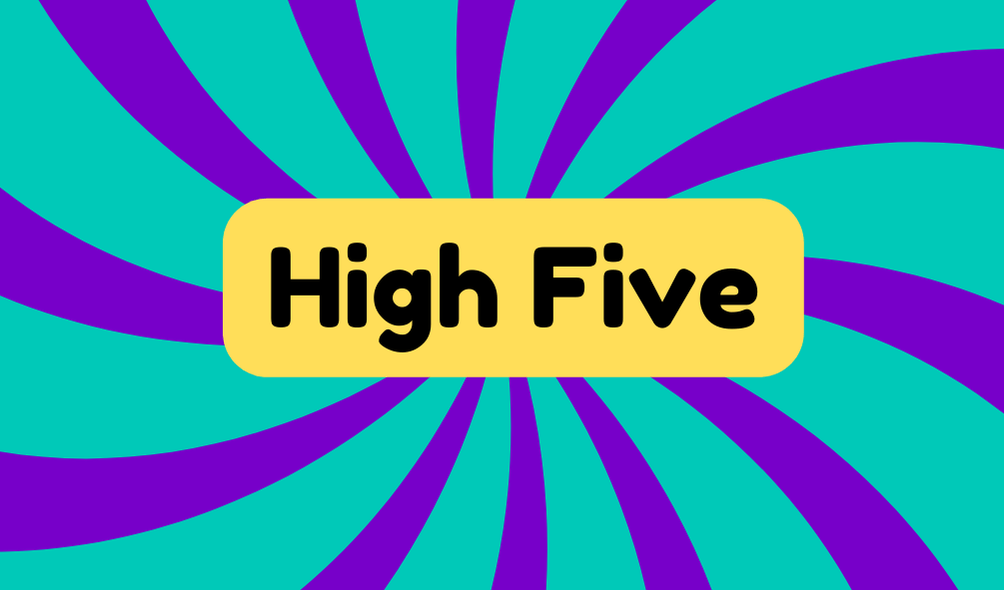A high five is a celebratory gesture where two people raise a hand and slap each other's palms, symbolizing excitement and camaraderie. It originated in the late 1970s, popularized by baseball player Dusty Baker, and has since evolved into a common way to express approval and shared achievement. It's important to recognize that while high fives can strengthen social bonds, relying too heavily on them might overshadow deeper acknowledgments. For instance, saying, "A high-five after the big win was electric!" captures its spirit. Understanding its history and cultural significance just might change how you view this playful act.
Synonyms
When you think about high-fives, you might also consider several synonymous gestures that convey similar feelings of celebration and camaraderie. While some might dismiss these as mere variations, they each have unique contexts and purposes that merit attention.
- Fist bump: A compact gesture, demonstrating solidarity, especially in more casual settings.
- Hand slap: A direct cousin to the high-five, emphasizing quick exchanges with an air of playfulness.
- Shoulder bump: Often used in more informal environments, it's a celebratory gesture that radiates energy and spontaneity.
While these hand slapping gestures each have their place in social interactions, they don't quite replicate the electrifying joy of a high-five. Consider how context influences their effectiveness, especially as you navigate the dynamics of celebration.
Example of Sentences
High-fives come with a variety of expressive sentences that capture their celebratory spirit. You might find yourself using high-fives in these contexts:
- "A high-five after closing that big deal felt electric!"
- "He didn't get a high-five for his late arrival to the meeting, and it stung a bit."
- "You'll earn a high-five if you ace that test next week!"
These sentences showcase the high-five as a hand gesture that embodies excitement and recognition. Yet, consider how often we take this celebratory expression for granted. While they spread joy, could reliance on such gestures dilute deeper acknowledgments? Reflecting on their meaning may lead you to realize the importance of interaction beyond just a quick slap of hands.
Origin
The high-five has its roots in the late 1970s, emerging as a dynamic gesture of celebration among athletes. You might not realize that it was popularized by Dusty Baker, an Astros outfielder, who used it after his teammate scored. This high five tradition quickly caught on, spreading through various sports teams as a more personal celebratory gesture compared to a standard handshake.
Over time, it transformed beyond the field, becoming widely recognized in different contexts—for approval, solidarity, or teamwork. While this gesture may seem simple, it symbolizes a shared sense of triumph. However, you should consider whether it's always taken seriously or if its frequent use has diluted its original meaning.
Collocations
With celebratory moments in mind, you'll often hear collocations that naturally pair with "high five." Common phrases include "give a high five," "receive a high five," and "celebratory high five," all of which emphasize the action and context of this gesture.
Here are three notable collocations to reflect on:
- Strike a high five – capturing that moment of connection.
- Air high five – adapting to cultural variations or social distancing.
- High five variations – illustrating how this simple gesture morphs across different cultures.
Each phrase paints a clearer picture, showing how high fives have evolved. The cultural adaptations highlight how this gesture transcends its roots, reminding us of our connection to shared experiences and community celebration, albeit perhaps with an eye towards overuse.
How to Use in Everyday Language
Often, you'll find yourself in situations where a high five perfectly captures the moment. Whether it's in the workplace, a classroom, or during social gatherings, using this gesture has become a convenient cultural expression. In everyday contexts, consider giving a high five after achieving a team goal or when encouraging others to keep trying. This simple act fosters camaraderie and creates a sense of shared joy. However, be mindful that not everyone appreciates physical touch, so gauge your audience. While high fives can elevate the energy in a room, they shouldn't replace genuine communication. Ultimately, knowing when and how to use this gesture can transform moments, injecting excitement and enthusiasm into your daily interactions without overstepping social boundaries.
Why Is It Still Relevant Today?
High fives remain a significant part of our interactions because they tap into our innate need for connection and shared experiences. Their cultural significance goes beyond simple celebration; it reflects our desire for a physical connection. In a world often dominated by digital communications, this gesture serves as a powerful reminder of our humanity. It's not just about the excitement; it's about strengthening bonds, whether after a team victory or within the workplace. Yet, while high fives can boost morale, they shouldn't overshadow deeper forms of collaboration and support. Understanding their role in our social fabric today is essential for fostering authentic interactions that truly engage and unite us beyond the quick slap of hands.







